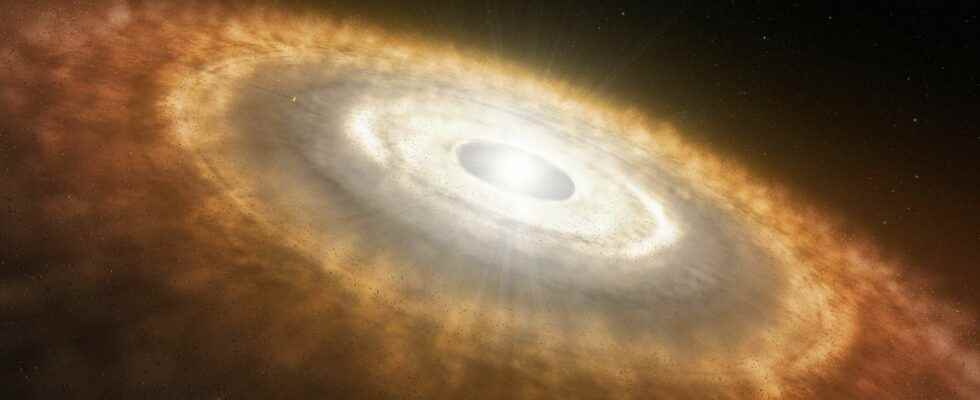You will also be interested
[EN VIDÉO] A protoplanetary disc torn apart by its three stars The space is home to as many delicate spectacles as violent events. Witness the observations made using the VLT and Alma, revealing behind the scenes of the birth of planets.
the carbon monoxide is an extremely common compound in protoplanetary disks, those regions of dust and gas where planets form around young stars, making it a prime target for scientists. However, observations made over the past ten years show abundances much lower than those predicted: “ depending on the system observed, the amount of carbon monoxide is three to one hundred times lower than it should be », explains Diana Powell, Nasa Hubble Fellow to Center for Astrophysics, Harvard & Smithsonian.
When gas becomes ice
A new model, validated by observations made with Alma, solved the mystery: carbon monoxide would hide in ice formations inside the discs. Powell et al.’s results are described in an article appeared in Nature Astronomy.
Inaccuracies on carbon monoxide could have huge implications for the field of astrochemistry: Carbon monoxide is basically used to trace everything we know about disks, like their mass, composition, and temperature, explains Powell. This could mean that many of our results for discs are biased and uncertain because we don’t understand the compound well enough. “.
Powell, expert in physical of the phase changesmade changes to a template astrophysics currently used to study the clouds on exoplanets. ” What’s really special about this model is that it has detailed physics of how ice forms on particles, so how ice accumulates on small particles then how it condenses. The model carefully tracks where the ice is, what particle it is on, how big the particles are, and how they move. »
A model that sticks to observations
Powell applied the model to multiple planetary disks in hopes of better understanding how carbon monoxide changes over time in planetary nurseries. To test the validity of the model, Powell then compared his results to actual observations of carbon monoxide by Alma in four well studied discs: TW Hydrae, HD 163296DM Tauri and IM Lupi.
According to Powell, the results and the models worked very well. The new model stuck with every observation, showing that the four discs weren’t running out of carbon monoxide but that the latter had just turned into ice, currently undetectable with a telescope. The radio observatories as Alma indeed allow the astronomers to see carbon monoxide in space in its gaseous phase, but ice is much harder to detect with current technology, especially large ice formations.
The model shows that, contrary to what we thought so far, carbon monoxide forms on large ice particles, especially after a million years. Before a million years, carbon monoxide gas is abundant and detectable in the discs.
Powell explains that ” it changes the way we thought ice and gas were distributed in the discs. It also shows that a modelization detail like this is important for understanding the fundamentals of these environments “.
Powell hopes his model can be further validated using observations made with the space telescope James Webbwho is maybe quite powerful to finally detect ice in the discs, but that remains to be seen.
What you must remember
- Carbon monoxide is extremely common in protoplanetary disks, but observations made over the past decade show much lower abundances than predicted.
- A new model shows that carbon monoxide would hide in ice formations inside the discs.
- This model matches real Alma observations of several well-studied planetary disks.
Interested in what you just read?
